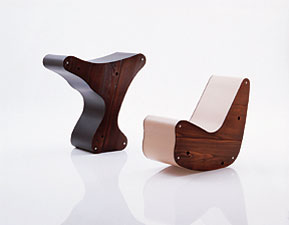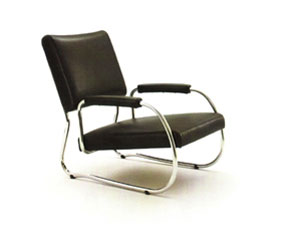Opening: New Location for the Kiesler Foundation, Vienna
Mariahilfer Straße 1B/Top1, 1060 Vienna
on Monday, May 2nd, 2005
Press conference in presence of
Franz Morak, State Secretary for Arts and Media;
Andreas Mailath-Pokorny, City Councillor for Culture and Science;
Brigitte Böck, Director of the Cultural Section of the bm:bwk;
Heinz Hofer-Wittmann, Partner and Founder;
Dieter Bogner, President of the Board of the Kiesler Foundation.
The Kiesler Foundation Vienna is the starting point of many exhibition and research activities which are closely connected to Kiesler’s extensive oeuvre. It is also a destination for scholars and researchers from different fields. That’s why is a task of the Kiesler Foundation to research the large estate purchased in 1997 and to throw it as a lively impulse in the contemporary discourse.
The cooperation with donors, founders and sponsors of the recent years, made possible for the Kiesler Foundation to be an institute for research and a service centre for art and architecture scene in its city.
“Friedrich Kiesler’s cross-border and multifaceted work as architect, artist, designer, stage designer and theoretician is actual more than ever. His works have oriented the ways architecture has followed as well as the interface between art and project planning. Few years ago, the Republic of Austria and the City of Vienna in cooperation with the Kiesler Foundation have created a well-remunerated prize for architecture to acknowledge Kiesler’s work. I am glad that the Kiesler Foundation makes available its treasures to the public, allowing a confrontation with his work. Thanks to this, the Kiesler Foundation will become stronger than before in the Austrian and in the international art scene”
(Franz Morak, State Secretary for Arts and Media)
“The newly reopened Foundation is a treasure for art and science, anchored to the Viennese cultural scene thanks to its new location. The Kiesler Foundation participates in the group of major international institutions in Vienna, together with Arnold Schönberg Center and
Sigmund Freud Museum. The cycle completes itself bringing back those intense and influential personalities to Vienna, the city where it all started”.
(Dr. Andreas Mailath-Pokorny, city councillor for culture and science)
“Since its founding in 1997, The Kiesler Foundation Vienna has been a place for scientific research, protection, and communication of Frederick Kiesler’s work, which had important influence on art production and theory construction up to the present times. The opening of a new centrally located place makes accessible to a large public both the Kiesler Archive and the Kiesler Library.
This research institution acts as a lively platform for scientific and interdisciplinary exchange of information between theoreticians, architects and artists and enriches Austrian cultural development in the international architecture and art discourse.
I wish to the Kiesler Foundation Vienna to welcome many interested visitors in its new premises and to become a pulsating centre for communication of ideas and of Kiesler oeuvre”
(Dr. Brigitte Böck, director of the cultural section of the bm:bwk)
The Program of the Kiesler Foundation 2005 includes presentations of unpublished materials, original drawings, architectural plans and texts as well as exhibitions and lectures of Austrian and international experts on theory and practise in the context of historical and contemporary architecture and art production.
The renovation of the new space has been possible thanks to the generous support of the following institutions and firms: Bundesministerium für Bildung, Wissenschaft und Kultur; Kulturabteilung der Stadt Wien; BAWAG PSK Gruppe; Österreichische Lotterien; bogner.cc; Gesellschaft der Freunde der bildenden Künste; Pflaum Karlberger Wiener Opetnik Rechtsanwälte; WITTMAN MÖBELWERKSTÄTTEN; ZUMTOBEL STAFF;
Generali Versicherung AG; MACKE Malerbetrieb.
Monika Pessler
Director
Kiesler Foundation Vienna
On the exhibition: Friedrich Kiesler - Designer on the occasion of the Re-Edition Friedrich Kiesler
A cooperation of the Kiesler Foundation Vienna with Wittmann Möbelwerkstätten
The exhibition shows previously unseen material ranging from early furniture sketches, from the 1920s to the late 1940s and offers a new insight in Kiesler’s artistic intentions.
The architect, stage designer and artist Frederick Kiesler was acclaimed for his City in Space in the Parisian “Exposition Internationale des Arts Décoratifs et Industriels Modernes” in 1925. This work became eventually a watershed in the history of modern design. The artistic avant-garde expressed its critical position towards the fair which mainly consisted of Art Déco furniture. Moreover they supported a modern design process related to the actual methods of industrial production.
Frederick Kiesler moved to New York in 1926. There he started to act as mediator between the European and American positions within the design and architecture discourse. The exhibition „Modern Architecture: International Exhibition“ in the Museum of Modern Art, provoked an animated discussion on an up-to-date expression of modern artistic preoccupations.
After 1933 Kiesler’s design sketches and architecture projects are characterized by a round-shaped, organic form which exemplifies his critique to a formal and empty of content approach to architecture and design.
During his academic activity at the Laboratory for Design Correlation at Columbia University in New York (1937-41), Kiesler deepened his theoretical concerns and published numerous articles on his holistic design and architecture theory named correalism.
The catalogue „Friedrich Kiesler. Designer. Seating Furniture of the 30s and 40s“ Hatje Cantz, Ostfildern, 2005 will be presented on the occasion of the exhibition and re-edition of Frederick Kiesler’s Correalist Furniture, Bed Couch, Party Lounge, Freischwinger No. 2
Exhibition opening: KIESLER UNFOLDED
May 20, 2005, 7p.m. in the Kiesler Foundation
Friedrich Kiesler’s unconventional architectural projects are organised after four categories: Twisting, Curving, Shaping and Layering which define the process of the making rather than the object’s characteristics. The exhibition aims at underlining the coherence between Kiesler’s multi-faceted approach to the discipline of architecture and the final results as they can be seen in the Endless House, the World House Galleries, the Shrine of the Book and other built and un-built projects.
Exhibition Opening: Dorit Margreiter ZENTRUM
The installation Zentrum by Dorit Margreiter in the Kiesler Foundation Vienna provides us with a preliminary account of a pan-media debate on the socialistic architecture of the “Brühlzentrum” in Leipzig (2004/2005). The residential building was erected in the sixties and is the exemplary starting point of a critical inspection of the utilisation of modernistic, aesthetic mediation strategies for the promotion of socio-political constructions.
Dorit Margreiter analyses this urbanistic intervention, which is close to demolition and its typographic design as evidence of a societal reform process.
In her artistic documentation she retains the memory of a specific expression of a value system which, due to its failure, is about to disappear. Moreover, she transfers the aesthetic codes of the time into the present, making them available for current use by reworking the scripture fixed to the building and its typology for the digital medium. The medium of the film is of special importance in this work. Both its suitability to grasp historical contexts and its ability to present virtual realities, convey to us in an impressive manner Dorit Margreiter’s conceptual notion of art.
Exhibition: Towards a Choreography of Change
September 2005, Dublin, Ireland
Choreography, traditionally understood as the arrangement of movement in time and space, is the creative act of setting humans, actions and thoughts in relation to one another, to create order and the conditions for something to happen. Framemakers examines this creative act of ordering and explores its application in/to a world in constant movement.
In addition to Kiesler’s texts on the theory of correalism, which are shown separately, the exhibition features works by artists such as Joseph Beuys and John Cage.
Exhibition: Maurizio Sacripanti. Architecture and Visual Language
Selected Projects 1961-1996
October 20th, 2005, 7 p.m. in the Kiesler Foundation Vienna
The Kiesler Foundation Vienna presents, for the first time in Austria, a few innovative projects by Italian architect Maurizio Sacripanti (1916-1996).
The work of the Roman architect occupies an exceptional position in the development of Italian architecture of the post-war period. In some sketches from the 1950s and 1960s, Sacripanti combines his interest for art, film and design with the scientific and technical characteristics of building.
Projects such as the Peugeot skyscraper in Buenos Aires (1961), the Teatro Lirico for the city of Cagliari (1965) and the Italian Pavilion for the World Expo in Osaka (1968) illustrate Sacripanti’s early occupation with and interest in interdisciplinary strategies of designing space.
Sacripanti’s update of Modernistic ideas, such as those of Frank Lloyd Wright, culminates in the realisation of the Museum in Maccagno, which was completed in the mid-nineties.
The exhibition „Maurizio Sacripanti. Architecture and the Language of Images“ includes loans from the collection of the Accademia Nazionale di San Luca in Rome, i.e. five original projects from the 1960s to the 1980s. Many photographs of the collection Giancotti will be shown along with sketches and architectural plans. With their independent aesthetic features, these photographs enrich the documentation of Sacripanti’s creative design process.
Exhibition: The Imagery of Chess
Noguchi Museum, Long Island City
Oktober 20, 2005 until March 2006
The exhibition “The Imagery of Chess Revisited” at the Noguchi Museum in Long Island City is dedicated to the groundbreaking exhibition “The Imagery of Chess” initiated by Max Ernst, Marcel Duchamp at the legendary Julien Levy Gallery in New York, 1944/45.
Amongst others the guest-curator Larry List chose twelve to thirteen original chessboards as well as numerous paintings and sculptures, which were shown in New York in 1944. Works of Friedrich Kiesler, Andre Breton, Alexander Calder, Joseph Cornell, Marcel Duchamp, Max Ernst, Arshile Gorky, Man Ray, Matta, Robert Motherwell, Isamu Noguchi, Kay Sage, Yves Tanguy, and Dorothea Tanning will be shown. The exhibition will be accompanied by a detailed publication edited by George Braziller.

Kiesler Foundation Vienna

Kiesler Foundation Vienna

Friedrich Kiesler, Designer. Seating Furniture of the 30s and 40s, Ed. Austrian Frederick and Lillian Kiesler Private Foundation, Hatje Cantz, Ostfildern-Ruit 2005

Re-Edition: Frederick Kiesler, Correalistic Instrument and Rocker, in cooperation with Wittmann Möbelwerkstätten, 2005

Re-Edition: Frederick Kiesler, Bed Couch, in cooperation with Wittmann Möbelwerkstätten, 2005
Photo: Katsey

Re-Edition: Frederick Kiesler, Party Lounge, in cooperation with Wittmann Möbelwerkstätten, 2005
Photo: Katsey

Re-Edition: Frederick Kiesler, Freischwinger No. 2, in cooperation with Wittmann Möbelwerkstätten, 2005
Photo: Katsey

Dorit Margreiter
Zentrum

Dorit Margreiter
Zentrum

Design for the italian Pavillon, Expo 1970, Osaka,
Modell